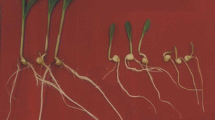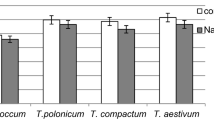Abstract
The Casparian strip in the endodermis of vascular plant roots appears to play an important role in preventing the influx of salts into the stele through the apoplast under salt stress. The effects of salinity on the development and morphology of the Casparian strip in primary roots of maize (Zea mays L.) were studied. Compared to the controls, the strip matured closer to the root tip with increase in the ambient concentration of NaCl. During growth in 200 mM NaCl, the number and the length of the endodermal cells in the region between the root tip and the lowest position of the endodermal strip decreased, as did the apparent rate of production of cells in single files of endodermal cells (the rate of cell formation being equal to the rate at which cells are lost from the meristem). The estimated time required for an individual cell to complete the formation of the strip after generation of the cell in the presence of 200 mM NaCl was not very different from that required in controls. Thus, salinity did not substantially affect the actual process of formation of the strip in individual cells. The radial width of the Casparian strip, a morphological parameter that should be related to the effectiveness of the strip as a barrier, increased in the presence of 200 mM NaCl. The mean width of the lignified region was 0.92 μm in distilled water and 1.33 μm in 200 mM NaCl at the lowest position of the strip. The mean width of the strip relative to that of the radial wall at this position was significantly greater after growth in the presence of 200 mM NaCl than in the controls, namely, 20.5% in distilled water and 33.9% in 200 mM NaCl. These observations suggest that the function of the strip is enhanced under salt stress.



Similar content being viewed by others
References
Azaizeh H, Steudle E (1991) Effects of salinity on water transport of excised maize (Zea mays L.) roots. Plant Physiol 97:1136–1145
Azaizeh H, Gunse B, Steudle E (1992) Effects of NaCl and CaCl2 on water transport across root cells of maize (Zea mays L.) seedlings. Plant Physiol 99:886–894
Baker DA (1971) Barriers to the radial diffusion of ions in maize roots. Planta 98:285–293
Barnabas AD, Peterson CA (1992) Development of Casparian bands and suberin lamellae in the endodermis of onion roots. Can J Bot 70:2233–2237
Barrieu F, Chaumont F, Chrispeels M (1998) High expression of the tonoplast aquaporin ZmTIP1 in epidermal and conducting tissues of maize. Plant Physiol 117:1153–1163
Brundrett MC, Enstone DE, Peterson CA (1988) A berberine-aniline blue fluorescent staining procedure for suberin, lignin, and callose in plant tissue. Protoplasma 146:133–142
Bryant AE (1934) A demonstration of the connection of the protoplasts of the endodermal cells with the Casparian strips in the roots of barley. New Phytol 33:231
Clarkson DT, Robards AW (1975) The endodermis, its structural development and physiological role. In: Torrey JG, Clarkson DT (eds) The development and function of roots. Academic Press, London, pp 415–436
Enstone DE, Peterson CA (1992) The apoplastic permeability of root apices. Can J Bot 70:1502–1512
Enstone DE, Peterson CA (1997) Suberin deposition and band plasmolysis in the maize (Zea mays L.) root exodermis. Can J Bot 75:1188–1199
Frensch J, Steudle E (1989) Axial and radial hydraulic resistance to roots of maize (Zea mays L.) Plant Physiol 91:719–726
Haas DL, Carothers ZB (1975) Some ultrastructural observations of endodermal cell development in Zea mays roots. Am J Bot 62:336–348
Harrison-Murray RS, Clarkson DT (1973) Relationships between structural development and the absorption of ions by the root system of Cucurbita pepo. Planta 114:1–16
Hayat MA (1986) Basic techniques for transmission electron microscopy. Academic press, Orlando, FL
Karahara I, Shibaoka H (1992) Isolation of Casparian strips from pea roots. Plant Cell Physiol 33:555–561
Karahara I, Shibaoka H (1994) The Casparian strip in pea epicotyls: effects of light on its development. Planta 192:269–275
Karahara I, Shibaoka H (1998) Effects of Brefeldin A on the development of the Casparian strip in pea epicotyls. Protoplasma 203:58–64
Kurth E, Cramer GR, Laeuchli A, Epstein E (1986) Effects of NaCl and CaCl2 on cell enlargement and cell production in cotton roots. Plant Physiol 82:1102–1106
Lehmann H, Stelzer R, Holzamer S, Kunz U, Gierth M (2000) Analytical electron microscopical investigations on the apoplastic pathways of lanthanum transport in barley roots. Planta 211:816–822
Lüttge U, Weigl J (1962) Mikroautoradiographische Untersuchungen der Aufnahme und des Transportes von 35SO4 2− und 45Ca2+ in Keimwurzeln von Zea mays und Pisum sativum L. Planta 58:113–126
Lux A, Luxova M (2001) Secondary dilatation growth in the root endodermis. In: Gasparikova O, Ciamporova M, Mistrik I, Baluska F (eds) Recent advances of plant root structure and function. Kluwer, Dordrecht, pp 31–37
Nagahashi G, Thompson WW, Leonard RT (1974) The Casparian strip as a barrier to the movement of lanthanum in maize roots. Science 183:670–671
Perumalla CJ, Peterson CA (1986) Deposition of Casparian bands and suberin lamellae in the exodermis and endodermis of young maize and onion roots. Can J Bot 38:1872–1878
Perumalla CJ, Peterson CA, Enstone DE (1990) A survey of angiosperm species to detect hypodermal Casparian bands. I. Roots with a uniseriate hypodermis and epidermis. Bot J Linn Soc 103:93–112
Peterson CA, Perumalla CJ (1990) A survey of angiosperm species to detect hypodermal Casparian bands. II. Roots with a multiseriate hypodermis or epidermis. Bot J Linn Soc 103:113–125
Peterson CA, Murrmann M, Steudle E (1993) Location of the major barriers to water and ion movement in young roots of Zea mays L. Planta 190:127–136
Reinhardt DH, Rost TL (1995) Salinity accelerates endodermal development and induces an exodermis in cotton seedling roots. Environ Exp Bot 35:563–571
Robards AW, Robb ME (1972) Uptake and binding of uranyl ions by barley roots. Science 178:980–982
Schreiber L (1996) The Casparian strip of Clivia miniata Reg. roots: evidence for lignin. Planta 199:596–601
Schreiber L, Hartmann K, Skrabs M, Zeier J (1999) Apoplastic barriers in roots: composition of endodermal and hypodermal cell walls. J Exp Bot 50:1267–1280
Spurr AR (1969) A low viscosity epoxy resin embedding medium for electron microscopy. J Ultrastruct Res 26:31–43
Wilcox H (1962) Growth studies of the root of incense cedar, Libocedrus decurrens I. The origin and development of primary tissues. Am J Bot 49:221–236
Yokoyama M, Karahara I (2001) Radial widening of the Casparian strip follows induced radial expansion of endodermal cells. Planta 213:474–477
Zeier J, Schreiber L (1997) Chemical composition of hypodermal and endodermal cell walls and xylem vessels isolated from Clivia miniata. Plant Physiol 113:1223–1231
Zeier J, Goll A, Yokoyama M, Karahara I, Schreiber L (1999a) Structure and chemical composition of endodermal and rhizodermal/hypodermal walls of several species. Plant Cell Environ 22:271–279
Zeier J, Ruel K, Ryser U, Schreiber L (1999b) Chemical analysis and immunolocalisation of lignin and suberin in endodermal and hypodermal/rhizodermal cell walls of developing maize (Zea mays L.) primary roots. Planta 209:1–12
Zidan I, Azaizeh H, Neumann PM (1990) Does salinity reduce growth in maize root epidermal cells by inhibiting their capacity for cell wall acidification? Plant Physiol 93:7–11
Zimmermann HM, Hartmann K, Schreiber L, Steudle E (2000) Chemical composition of apoplastic transport barriers in relation to radial hydraulic conductivity of maize roots (Zea mays L.). Planta 210:302–311
Acknowledgements
This work was supported by a Grant-in-Aid for Scientific Research (no. 11740454) from the Ministry of Education, Science, Sports and Culture of Japan, by a Sasakawa Scientific Research Grant from the Japan Science Society, and a grant for the improvement of education from Toyama University to I.K. The authors are grateful to Professors M. Sugai, K. Masuda and S. Kamisaka of Toyama University for their helpful suggestions and to Ms. H. Miyake for her skilled technical assistance.
Author information
Authors and Affiliations
Corresponding author
Rights and permissions
About this article
Cite this article
Karahara, I., Ikeda, A., Kondo, T. et al. Development of the Casparian strip in primary roots of maize under salt stress. Planta 219, 41–47 (2004). https://doi.org/10.1007/s00425-004-1208-7
Received:
Accepted:
Published:
Issue Date:
DOI: https://doi.org/10.1007/s00425-004-1208-7




